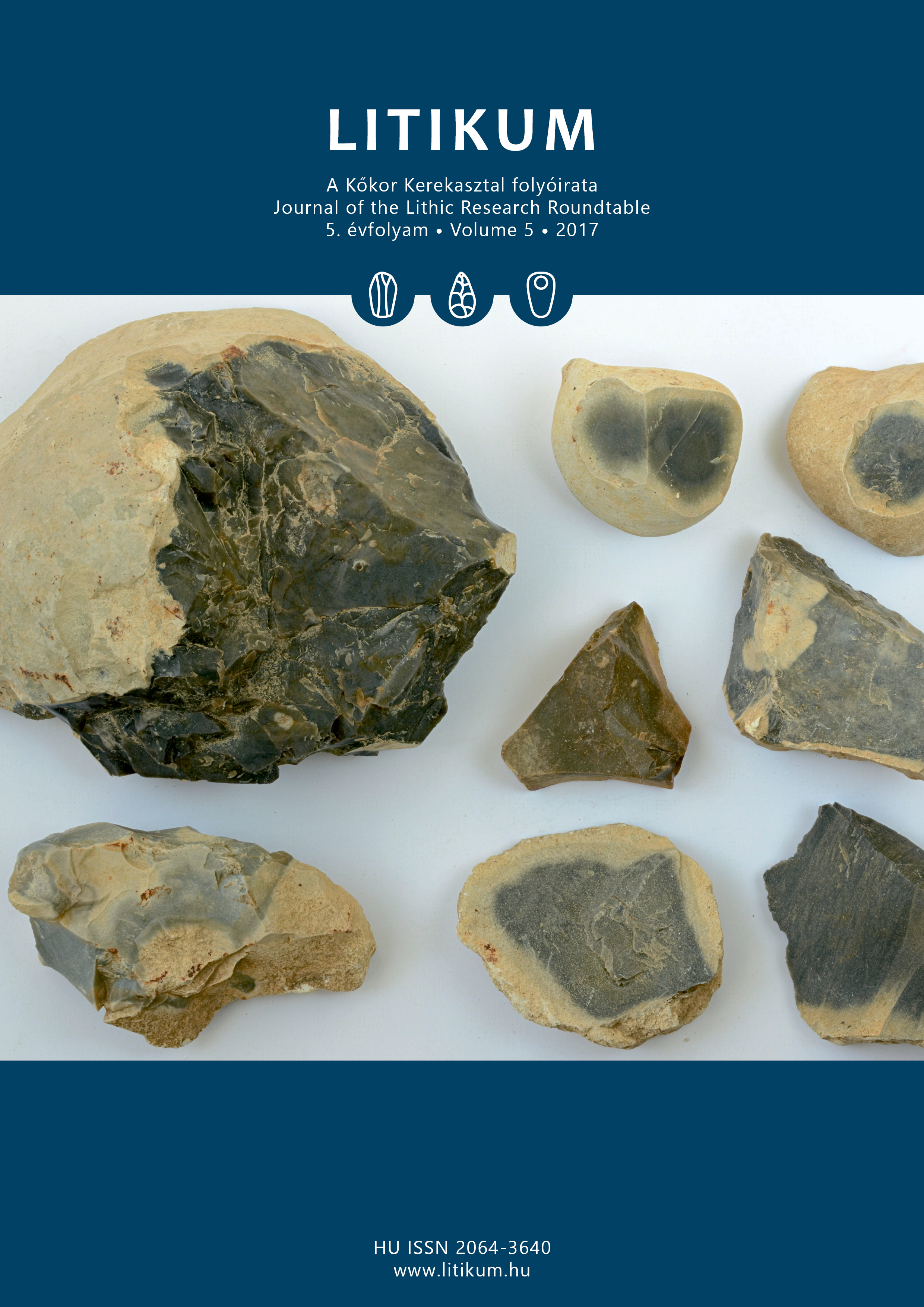Preliminary results of the recent excavation of a radiolarite mine area and its surroundings in Sedmerovec
Ivan Cheben1, Michal Cheben2, Adrian Nemergut3
1 Institute of Archaeology Slovak Academy of Sciences, Akademicka 2, 949 21 Nitra, Slovak Republic, Email: ivan.cheben@savba.sk
2 Institute of Archaeology Slovak Academy of Sciences, Akademicka 2, 949 21 Nitra, Slovak Republic, Email: nraumche@savba.sk
3 Institute of Archaeology Slovak Academy of Sciences, Akademicka 2, 949 21 Nitra, Slovak Republic, Email: adrian.nemergut@savba.sk
Cite as Cheben, I., Cheben, M. & Nemergut, A. (2017). Preliminary results of the recent excavation of a radiolarite mine area and its surroundings in Sedmerovec. Litikum – Journal of the Lithic Research Roundtable, 5, pp. 7–14. https://doi.org/10.23898/litikuma0020
Abstract. The article deals with the archaeological investigation of Sedmerovec-Ka.nak and Sedmerovec-Podjamie sites from 2016. In Sedmerovec-Ka.nak mine area, archaeological investigations were carried out in the western half of the pit. Unfortunately, no archaeological material was found. During the surface survey and archaeological excavation in Sedmerovec-Podjamie site, a rich collection of a lithic industry was obtained. Important are rhomboids most probably from the late Mesolithic. A portion of the artifacts belongs to the Neolithic and Eneolithic.
Keywords: Slovakia, White Carpathians, sources of radiolarites, mining areas, lithic industry, late Mesolithic, Neolithic, Eneolithic
Data availability statement: The author[s] confirm[s] that the data supporting the findings of this study are available within the article [and/or] its supplementary materials.
Disclosure statement: No potential conflict of interest was reported by the author.
Funding statement: The author received no financial support for the research and/or the publication of this article.
Copyright: This is an open access article distributed under the terms of a Creative Commons Attribution-NonCommercial-ShareAlike International Public License (CC BY-NC-SA 4.0). You are free to copy and redistribute the material in any medium or format, and transform the material, under the following terms: You must give appropriate credit, provide a link to the license, and indicate if changes were made. You may not use the material for commercial purposes. If you remix, transform, or build upon the material, you must distribute your contributions under the same license as the original.
List of references
Bárta J. 1965. Slovensko v staršej a strednej dobe kamennej. Bratislava.
Broglio A., Kozłowski S. K. 1984. Tipologia ed evoluzione delle industrie mesolitiche di Romagnano III. Preistoria Alpina 19: 93–148.
Cheben I., Illášová Ľ., Hromada J., Ožvoldová L., Pavelčík J. 1995. Eine Oberflächengrube zur Förderung von Radiolarit in Bolešov. Slovenská Archeológia 63:185–203.
Cheben I., Illášová Ľ., Hromada J. 1996. Povrchový prieskum rádiolaritov v Bolešove. AVANS 1994: 98–99.
Cheben I., Cheben M. 2010. Research on Radiolarites of the White Carpathian Klippen Belt. Slovenská archeológia 58: 13–52.
Cheben I., Cheben M., Nemergut A., Soják M. in print. The latest knowledge in use of primary sources of radiolarites in the central Váh region (the microregion of Nemšová-Červený Kameň). In: Budziszewski J., Werra D. H., Woźny M. (eds.), Jacek Lech – special dedicatory volume. Warszawa.
Gehlen B. 2009. Innovationen und Netzwerke. Das Spätmesolithikum vom Forggensee (Südbayern) im Kontext des ausgehenden Mesolithikums und des Altneolithikums in der Südhälfte Europas. Archäologische Informationen 32: 173–185.
Gehlen B. 2010a. Innovationen und Netzwerke. Das Spätmesolithikum vom Forggensee (Südbayern) im Kontext des ausgehenden Mesolithikums und des Altneolithikums in der Südhälfte Europas. Edition Mesolithikum 2. Kerpen-Loogh.
Gehlen B. 2010b. Neolithic transition processes in Southern Europe: The present state of knowledge and its deficiencies in Northern Italy and Southwestern France. In: Gronenborn D., Petrasch J. (eds.), Die Neolithisierung Mitteleuropas. Internationale Tagung, Mainz 24. bis 26. Juni 2005. The Spread of the Neolithic to Central Europe. International Symposium, Mainz 24 June – 26 June 2005. RGZM Tagungen. Mainz, 607–635.
Kaczanowska M., Kozłowski J. K., Wasilewski M. 2015. Chipped, ground and polished stone industries at the early Neolithic settlement of Moravany. In: Kozłowski J. K., Nowak M., Vizdal M. (eds.), Early Farmers of the Eastern Slovak Lowland: The Settlement of the Eastern Linear Pottery Culture at Moravany. Kraków, 163–196.
Kaminská Ľ., Kaczanowska M., Kozłowski J. K. 2008. Košice-Červený rak and the Körös/Eastern Linear transition in the Hornád basin (eastern Slovakia). Přehled výzkumů 49: 83–91.
Kozłowski J. K., Kozłowski S. K. 1984. Le Mésolithique a l’est des Alpes. Preistoria Alpina 19: 37–56.
Kozłowski J. K., Nowak M. 2010. From Körös/Criş to the early Eastern Linear Complex: multidirectional transitions in the north-eastern fringe of the Carpathian Basin. In: Kozłowski J. K., Raczky P. (eds), Neolithization of The Carpathian Basin, Northernmost Distribution of The Starcevo/Koros Culture. Kraków – Budapest, 65–90.
Mello J., et al. 2011. Vysvetlivky ku geologickej mape Stredného Považia 1:50 000. Bratislava.
Nemergut A., Cheben M., Gregor M. 2012. Lithic raw material use at the Palaeolithic site of Moravany nad Váhom-Dlhá. Anthropologie 50/4: 379–390.
Perrin T., 2009. New perspectives on the Mesolithic/Neolithic transition in northern Italy. In: McCartan S., Schulting R., Warren G., Woodman P. (eds.), Mesolithic horizons, Vol. 2. Oxford: Oxbow Books, 514–519.
Vlkolinská I., Illášová Ľ., Hunka J. 1998. Výsledky prieskumu na trase diaľnice. AVANS 1996: 170–171, 127–279.
Wąs M., 2011. „Janisławickie” i „wstęgowe” koncepcje rdzeniowania wiórowego. Próba konfrontacji technologicznej. Acta Universitatis Lodziensis. Folia Archaeologica 2012/28: 5–23.
Žaár O., Schreiber P., Štec L., Blašková Ľ. 2013. Nové povrchové nálezy z Bohuníc a Sedmerovca. AVANS 2009: 264–265, 342–346.


